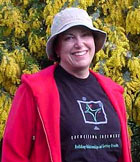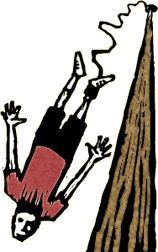Fall 2003
Reflections on Resilience
 The American
Heritage Dictionary defines resilience as, “The ability to recover
quickly from illness, change, or misfortune; buoyancy.” Anyone who
has followed the news of the past few years is aware of both the need for
and examples of resilience at a personal, organizational, national, and global
level. The recent anniversary of 9/11 reminds us of our ability as a nation
to recover a sense of meaning and hope after a devastating experience.
The American
Heritage Dictionary defines resilience as, “The ability to recover
quickly from illness, change, or misfortune; buoyancy.” Anyone who
has followed the news of the past few years is aware of both the need for
and examples of resilience at a personal, organizational, national, and global
level. The recent anniversary of 9/11 reminds us of our ability as a nation
to recover a sense of meaning and hope after a devastating experience.
Organizations that responded to changing market conditions with strategic thinking and creativity rather than fear and denial have been able to change and survive—even thrive—in the new reality. Many of us know individuals who have met the challenge of misfortune or illness with determination and optimism. Some of this may be inborn, some of it comes from experience, perhaps to some degree resilience can be learned by individuals and organizations. The articles in this issue focus on personal experiences of resilience; many of the lessons can be applied to organizations as well.
For the last several years, we have been developing tools to help organizations achieve resilience. To be able to bounce back, organizations need to have leaders who can think strategically and inspire others. Two of our most exciting new programs—Strategic Thinking: Leadership Practices for Innovative Organizations and Stone Soup Leadership: Inspiring Others to Do Great Things—help leaders develop these all-important skills. We’ve long emphasized the importance of taking intelligent risks and fostering a climate of innovation. Our Intelligent Risk-Taking and Creating a Culture for Risk and Innovation programs are especially appropriate for companies who want to build resilience and flexibility throughout their organization.
My longtime friend and colleague, Pat Newmann, one of the most effective and creative people in the organization development world, has a powerful message about resiliency, learned and practiced at both the personal and the professional level. In this newsletter, she will share some of her personal learning about resilience and in a future newsletter she will discuss how she has applied these principles to her work with organizations.
In this issue, I’m also reprinting an article I wrote some twelve years ago, after a devastating fire destroyed our home in the Oakland Hills. The article appeared in its current form in our first-ever newsletter, just months after 9/11. Our newsletter list has almost doubled since that first issue; I wanted to share my thoughts once again on resilience—bouncing back—from suddenly imposed change.
Here’s to resilience; long may we bounce!
—Kim
In this Issue:
- “Bounce Back:Resiliency from the Inside Out” (Part 1), by Pat Newmann, Your Partner in Change
- “The Fire this Time” by B. Kim Barnes
- “A Walk in The City: Personal Reflections of an Avon Walker for Breast Cancer”
- What’s New at Barnes & Conti
- Public Programs for 2004
- New Partners in England and Australia
- Upcoming Public Programs
- In the News: “Find ’m, Train ’em, Pay ’em” (Effective Leadership Development)
- Recipe:Eggplant Caprese
- Just for Fun: Bouncing Back?
- Featured art (above), “The Harvest”, Pieter Brueghel the Elder
Bounce Back: Resiliency from the
Inside Out (excerpt from Part 1)
Pat Newmann, Your Partner in Change
Introduction:
In my consulting with organizations going through change, I’ve noticed that some people are markedly more resilient than others. Some are capable of moving through complex and difficult change with remarkable resiliency and some are not. Some are resilient through one change and not so through another. I’ve noticed similar dynamics in my own life. I navigate some life changes with remarkable resiliency and not so with others. For many years, I’ve asked myself the question “What makes a person resilient?” I’ve interviewed hundreds of people and read scores of articles and books on the topic. I’ve learned that, for some people, resiliency is a natural state of being, partially genetic and also learned early in life. For others, it is a choice and a learned capability.
Recently, while navigating a life-threatening illness, I had the opportunity to practice what I’ve learned. I tested many approaches and found that some worked better than others. I then developed a tool kit to share with others who wish to boost their resiliency.
Now that I am healthy and strong again, I’ve tested and refined the toolkit with a few hundred employees in a client company. The purpose of this article is to bring the tools to you. It is my sincerest wish that these tools will make a difference in your life.
The “BOUNCE BACK” Model:
In order to make the tools memorable, I’ve organized them using the acronym BOUNCE BACK. Each letter stands for one of the tools or practices.
B-O-U-N-C-E
“B” is for Breathe”
It all starts with the breath. The body requires breath to live. When we breathe in, we bring oxygen into the body through the lungs and cardiovascular system. When we breathe out, we release by-products. Breathing deeply and correctly releases muscle tension and provides oxygen to the organs and the brain. The heart functions more easily and the brain is more capable. Under these conditions, we are more able to think clearly and to intelligently navigate our way through difficult circumstances.
To
read the entire article, click here*.
Also available in Adobe Acrobat format, see below
Part 2 of this article, “Resiliency in Organizations” will appear in an upcoming newsletter.
The Fire This Time (excerpt)
B. Kim Barnes (reprinted from October 2001)
Ten years ago, (Note: now twelve years ago) the huge fire that raged through the hills of Oakland, California destroyed our house. We were fortunate—we lost property, not lives. We were well insured. We rebuilt our house and moved on. As part of the healing and rebuilding process, I wrote an article focusing on sudden change, entitled “The Fire this Time: Coping With Sudden Imposed Change.” The article came to me at midnight in a sleeper car of a train across central Europe about six weeks after the fire. It seemed to me that the article wrote itself—as if the lessons I had learned from the experience could suddenly be articulated. The article became part of a program we developed on change leadership. I think there is something in it that I can use and share once again...
...In the immediate aftermath of the fire and the ensuing months, I paid attention to my own reactions and responses and those of family and friends. I began to see how this experience could be a powerful metaphor that would help me gain understanding about coping with sudden, imposed change.
Looking back, I am, for the most part, comfortable with the actions my family and I took to restore our lives to something that is not the same but absolutely acceptable and even interestingly different. I'll make some applications to other situations in which change occurs that you didn't ask or prepare for and that causes serious loss. In doing so, however, I recognize that our loss was mitigated by a very good insurance policy; this doesn't exist for most people caught up in a large-scale organizational or political change. For those directly affected by catastrophic events such as the recent terror attack, I don't pretend to have any answers, only deep support and empathy. These thoughts are primarily for the benefit of those individuals and organizations who are caught up in the uncertainty of the changes wrought by these events. I am also aware that the particular action steps that were so useful to us may need to be modified to accommodate differences in personality, cultural values, and life experience.
To read the entire
article, click here*.
Also available in Adobe Acrobat format, see below
 A
Walk in the City: Personal Reflections of an
A
Walk in the City: Personal Reflections of an
Avon Walker for Breast Cancer (excerpted)
Janne Rochlin, Director of Client Services, Barnes & Conti
In 2001 I decided that I would dedicate my charity fund-raising to the Avon Foundation through the Avon Walks for Breast Cancer. Again this year, I walked with thousands of other people to demonstrate awareness of this disease and to raise money for the foundation. I admit; walking is not entirely altruistic. I needed to find a way to improve my own overall fitness and thus help stave off the disease. Walking for over 40 miles in two days and sleeping in two-person tent in the San Francisco “summer” (howling winds and pea-soup fog for those of you who have not been here in June and July) required that I get up and get moving. Add to that the challenge of fund-raising, asking people for money — could I just walk another 100 miles instead?
...The experience of walking with people of all ages, from all backgrounds, is life-changing. I have met survivors; some who are double and triple survivors, inspired me with their drive and spirit. I have met family members: daughters, sons, spouses, mothers and fathers, of those who were lost to the disease and experienced their dedication and commitment to the memories of their loved ones. I grew closer to my own daughter than I have ever been as we shared this experience.
...For my family and for my friends; for those who do not have the disease and who, with the help of the Avon Foundation and other foundations like it, won’t get it; for those who have it and are fighting; for those who had it and won; for those who had it and lost; in their honor, I walk. I hope some of you will consider walking with me.
To read the entire article, click here.
What’s New at Barnes & Conti?
Public Programs for 2004
We are currently setting our public program schedule for 2004. We’ll be offering a mix of our classic Barnes & Conti programs, Exercising Influence and Constructive Negotiation, as well as new, “hot off the press” programs such as Stone Soup Leadership and Strategic Thinking.
Our public programs provide an excellent opportunity to review one of our programs to see if it is a fit of employees from smaller companies to participate in high-quality programs with people from other organizations.
If you want to review a program, or if you have three or more from your organization/workgroup, please contact us; we generally have discounts available.
The schedule will be posted at the following URL:
http://www.barnesconti.com/ppsched.php
To register, either use our website, or call us at 510.644.0911
New Partners: Psychology Network Limited and Rogen
Psychology Network Limited (PNL) is a consulting group headquartered in the United Kingdom. PNL works with corporations and brings together best practices in coaching, corporate development, change management and business management assessment. Through a network of individual coaches and associate businesses, located across Europe, Asia and Australasia, PNL offers professional services in over twenty countries. PNL will be delivering Barnes & Conti programs in the United Kingdom, Switzerland, Germany, The Netherlands, and France.
To find out more about Psychology Network Limited, click here.
Rogen is a global communication consultancy headquartered in Australia that develops skills and strategies for high-stakes communicators. Rogen has been helping business leaders grow their enterprises through persuasive communication since 1968. They operate in more than 20 countries across all industry sectors and are able provide clients with both world and industry best practices. Rogen will be delivering Barnes & Conti programs throughout Asia Pacific including Australia, New Zealand, South Korea, China, Singapore, Hong Kong, and India.
To find out more about Rogen, click here.
Upcoming Public Programs
Exercising Influence
November 11-12, 2003, Milpitas, CA
Stone Soup Leadership (new program)
December 10-11, 2003, Milpitas, CA
From Conflict to Consensus
December 3-4, Milpitas, CA
COACH for Peak Performance
October 21, 2003, San Francisco, CA
To
register for one of our public programs, click here
or go to: www.barnesconti.com/ppsched.php
In the News: Effective Leadership Development
The San Francisco Chronicle recently ran an article on how the top 20 companies for leaders develop and retain their leaders. The article is called: “Find ’em, Train ’em, Pay ’em.” Below is a brief excerpt.
The companies that are best at developing leaders operate far differently from the rest of the pack, according to a new study by Hewitt Associates, the large human resources consulting firm. Hewitt analyzed leadership initiatives from 300 U.S. businesses and compared them with the “Top 20 Companies for Leaders” listed in this month’s issue of Chief Executive magazine.
Among the findings:
Only 32 percent of the people surveyed at the typical companies believe that their process for developing leaders is effective. At the top 20 companies, 85 percent feel that way.
(Dave Murphy, San Francisco Chronicle, October 4, 2003)
To read the article, click here
 Recipe:
Eggplant Caprese
Recipe:
Eggplant Caprese
Caprese is a traditional Italian appetizer of tomatoes, basil, and mozzarella cheese. In this variation, the traditional three are combined on top of a slice of grilled eggplant.
Ingredients:
- 4 small to medium globe eggplant
- 4-6 tomatoes
- 8 or more ounces fresh mozzarella cheese (this is a mild, soft cheese that comes in balls or ovals, if you can't find it, use regular, whole-milk mozzarella, but not as much), sliced (about 1/4 inch) or grated.
- 18-24 large leaves of fresh basil
- 1/4 cup extra virgin olive oil
- 2 large cloves garlic
Procedure:
- Prepare the eggplant by peeling, and slicing lengthwise into slices about 1/2 inch thick. Try to get four long slices from each eggplant. Salt the eggplant slices liberally and stand them up in colander to drain. Allow to drain for at least 1 hour. (This step is important, it drains off any bitter juice in the eggplant.
- While the eggplant slices are draining, press the two garlic cloves into the olive oil. Slice the tomatoes into thick slices (at least 1/4 inch). If the tomatoes are watery, you might want to drain the slices in a colander or strainer.
- When the eggplant slices have drained, rinse them well and pat dry. Preheat your broiler or grill, and broil or grill the eggplant for 4-6 minutes on each side; the eggplant should become light golden brown in places, and should begin to soften.
- Place the eggplant slices in a baking dish in a single layer. Allow to cool slightly.
- Preheat oven to 350 degrees.
- Assemble the caprese as follows: brush each eggplant slice with the garlic oil, place a layer of basil leaves on the eggplant, and a layer of tomato slices on top of the basil. Drizzle the tomatoes with any leftover oil. Top with the mozzarella cheese (leave some room around the edges, the cheese will melt and run).
- Bake at 350 degrees for 10-15 minutes, until the cheese has melted. Allow to cool almost to room temperature, and serve.
Serves eight as an appetizer or four as a light entreé.
Just for Fun:
 Bouncing
Back?
Bouncing
Back?
Two Americans, Bob and Jeff, decided to open a bungee-jumping business in Mexico.
They set up a tall platform in the square of a small village. Bob jumped, bounced at the end of the cord, and flew back up by the platform. Jeff wasn’t able to catch his friend, but he noticed that Bob had a few cuts and scratches.
Bob went down again, bounced, and came back up. This time, he was bruised and bleeding. Once again, Jeff couldn’t catch him.
The third time, Bob came back really messed up—he had a couple broken broken bones and was almost unconscious. Fortunately, Jeff caught him this time and said, “Holy cow, what happened? Was the cord too long??”
Bob gave him a bewildered look and said, “No, the cord was fine... but what the HECK is a piñata?”
For Inspiration:
Our editor found the following web site full of inspiring stories about resiliency. We wanted to share these with you.The stories are from a web site called “The Resiliency Center.”
To read the stories, go to:
http://www.resiliencycenter.com/storyarch.html
* Two of the articles are available in printer-friendly pdf/Adobe Acrobat Format. To download the files in pdf format, use the links below: Please note that Adobe Acrobat Reader is required to view and print these articles.
Please send feedback to newsltr1 at
barnesconti.com
Copyright © 2003 Barnes & Conti Associates, Inc. ALL RIGHTS RESERVED.
Please send feedback to newsltr1
at barnesconti.com
Barnes & Conti, 940 Dwight Way Suite 15, Berkeley, CA 94710, USA
Copyright © 2004 Barnes & Conti Associates, Inc. ALL RIGHTS
RESERVED.
Barnes & Conti is a spam-free zone. We do not sell, trade, or give email addresses to anyone.
